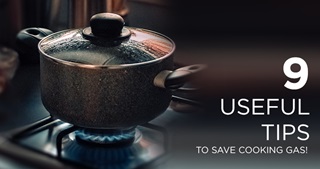9 Effective Tips to Save Cooking Gas at Home

Do you want to avoid
constantly running out of your LPG while whipping delicious meals at home? Making minor adjustments to
your cooking style can make a big difference. This blog will share nine
invaluable and easy tips to conserve your LPG gas.
Pressure Cooking
Pressure cooking saves cooking
time and fuel when compared to conventional cooking methods. According to the
PCRA, pressure cooking saves 20% of fuel on rice, 46% on soaked pulses, vegetables
on 50-70% and 41.5% on meat.
Cooking on Low Flame
When the flame is high, the
fuel is wasted in the form of heat. The excess flame that escapes the surface
of the pot or pan gets absorbed by the air surrounding it. Lowering the flame
after reaching the boiling point can save up to 25% fuel.
Soaking
Soaking food items like
lentils, rice, and other grains helps save fuel. As the food has already
absorbed the water, the water that needs to be evaporated during cooking is
reduced. Soaking not only saves gas but is also good for your health.
Cook in Wide Vessels
Cooking in wide vessels saves
fuel as the visible flame from the burner concentrates on the vessel's surface,
preventing it from being wasted. Wide vessels not only allow you to conserve gas
but also help you cook quickly and evenly.
Optimal Water Quantity
Excessive water in vessels
takes more time to evaporate, resulting in higher fuel consumption. Filling the
pots with excess water leads to overcooking or burning both, a waste of fuel and
food.
Use Small Burners
The small burners consume 6-
10% less fuel when compared to big burners, even when set on the same flame
height. A smaller burner radius means less heat is lost to the surroundings,
saving gas.
Use Lids while Cooking
Covering the pots and pans
while cooking not only helps you save fuel but is also a safe practice. When
you cook with the lid on, heat is trapped inside and makes the food cook
faster, which means less fuel consumption.
Clean Burners
The soot clogged the burners
acts as a barrier and takes more time for the vessels to heat up. Cleaner
burners also prevent flare-ups, which wastes fuel and can be dangerous. Watch
for yellow and orange flames, which are less effective at heating vessels. Make
sure to clean the burners regularly to save cooking gas.
Clean Vessels
Clean vessels have uncoated
surfaces, which allows heat transfer efficiently. The food residue, debris or
dirt acts as an insulator and prevents the heat from reaching the food. Clean
vessels not only save fuel while cooking but also promote a healthier
environment in the kitchen.
Incorporating these simple and
effective tips into your daily cooking routine can reduce fuel consumption.
Conserving fuel not only lowers your energy bill but also preserves valuable
resources. For more such LPG saving and safety tips visit Safety Tips forHome.